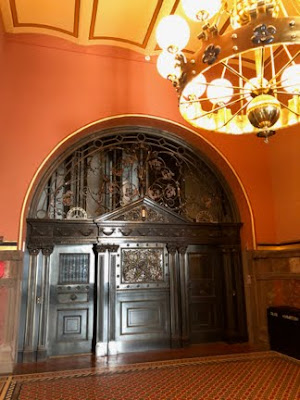Albany is a curious city. As the state capitol of New York, much public money has been spent on its government buildings. The city is almost entirely low-rise, with the exception of some modern governmental skyscrapers, which are poorly-integrated into the landscape of the city centre. They are connected by a cavernous underground plaza, the Nelson A. Rockefeller Empire State Plaza, lacking in amenities or storefronts. The whole complex was built between 1965 and 1976, at an estimated cost of $2 billion.
 |
| view of Albany's historic capitol building, surrounded by modernist government buildings |
Here is what architecture critic Martin Filler wrote about the complex, in The Making of Empire State Plaza:
"There is no relationship at all between buildings and site, neither at grade nor atop the podium, since all vestiges of the existing site have been so totally obliterated. Thus, as one stands on the Plaza itself, there is an eerie feeling of detachment. The Mall buildings loom menacingly, like aliens from another galaxy set down on this marble landing strip."The neighbourhood around the plaza is run-down, and includes a number of condemned buildings. Our innkeeper explained that the people who work for the state are well-paid, and want to live in the suburbs. What she didn't explain was that the centre of the city had been hollowed out by the evictions necessary to accommodate a modernist dream. I found out more about this history by reading the Wikipedia entry here.
Apparently there is a large collection of mid-century art in the complex. I saw only a few examples, and assume that one must enter the various skyscrapers to see the almost 100 sculptures and paintings.
Our hostess recommended a tour of the historic state capitol building. Here are some of the photos I took on the very informative tour.
 |
| This image of a hallway underlines the impressive nature of the state capitol building, built 1867-1899. The mosaic floor was laid piece-by-piece, by hand. |
 |
| Examples of fine craftsmanship abound. Much of the woodcarving was done on site, and the artisans were mostly immigrants from Scotland. |
 |
| Many of the materials were also imported, like this panelling of Italian marble. |
 |
| Originally, the building was to be capped with a dome, but the idea was scrapped due to structural concerns. |
A tour of the capitol building is offered four times daily, and I would recommend it. Albany also has two worthwhile museums within walking distance, the Albany Institute of History and Art and the New York State Museum.




No comments:
Post a Comment